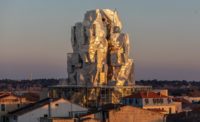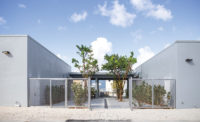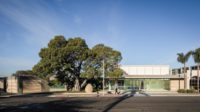In 1984, France’s national railway, the SNCF, shut down a rail yard with a handful of handsome 19th-century industrial sheds in the sun-washed southern city of Arles. The so-called Parcs des Ateliers, where broken trains had been repaired since the 1850s, was a major provider of employment in the town, which now numbers 54,000 inhabitants. But after the yards closed, the 16-acre sunken site remained unoccupied and unloved, a dustbowl next to the Avenue Victor Hugo, one of the city’s main roads. Only the historic Roman amphitheaters and favorite spots of Van Gogh (who produced 30 paintings here between 1888 and 1889) were able to shore up the town’s fortunes with tourism.
Additional Information:Jump to credits & specifications
But like plenty of other postindustrial sites–the power station in London that’s now the Tate Modern (RECORD, July 2016; June 2000), or the distillery in Milan that’s returned as the Prada Foundation (RECORD, July 2015)–culture has flowed like water into the spaces that industry left behind. In this case, a radical new arts campus is rising from the SNCF’s ashes, in the private hands of Maja Hoffmann, a Swiss pharmaceutical heiress, philanthropist, and collector of contemporary art, who arrived in Arles when she was just a few weeks old and considers it her hometown. Her foundation, Luma, begun in 2004 with the mission of spurring artistic activity rather than just exhibiting its results, will spend a sum estimated to be north of $100 million on the project. The centerpiece of the new Parc des Ateliers site is Frank Gehry’s dazzling (literally, with its stainless-steel cladding) 185-foot-high tower for an art and research center, which will open in 2018. Its architect says the clustered blocks are inspired by the rock formations that occur naturally in the region.
But in the meantime, New York–based Selldorf Architects completed the stunning conversion of two buildings last summer–Les Forges, or the foundry building, and the Mécanique Générale, which had been the main repair space. The adapted structures have already hosted a range of events, including performances by Benjamin Millepied’s L.A. Dance Project and an installation by artist Jordan Wolfson of a puppet in chains being thrown violently to the floor.
The firm’s principal, Annabelle Selldorf, was charged not only with turning the buildings into galleries, but with the master plan of the Parc as well. She was a natural choice, having both a long-standing relationship with the art world and a reputation for subtle renovation projects, such as making over a Manhattan roller-skating rink as an art gallery for Hauser + Wirth in 2013. “My work is about proportions, light, and integrity of structure—what the building brings to the project,” she says.
When Selldorf first visited Arles, she says, she “couldn’t take in the incredible size of the site.” The vast space is 23 feet below the street, on the same level as the railway. “You descend a slope to enter it. And this is not a ‘park’ in the usual sense—there’s all that dusty gravel and intense sun,” she adds. Accordingly, Selldorf is working with the Belgian landscape designer Bas Smets on developing a softer context, with newly introduced undulations and greenery that will guide visitors from building to building and create what Hoffmann calls “a public garden for my fellow citizens.”
At Les Forges, the architect inherited a gabled structure of soaring cast-iron columns and steel trusses, with limestone walls and clay-tile roofs. In this former foundry, Selldorf ripped off the old roof, replacing its tiles; stabilized the cast-iron structure; and added a mezzanine level to create a total of 31,000 square feet of gallery space. She installed concrete floors on the ground level and mezzanine, and, to get light to the interior, inserted glazing in the upper windows where smaller panes or plywood had been and in some of the lower-level openings, while adding a few skylights. In the middle of Les Forges is an open-air courtyard café, another amenity in this dramatic, elongated volume. “The galleries have worked really well for conferences and symposia through the winter, too,” says Selldorf.
The Mécanique building now offers a heroic, open-plan exhibition space of 48,000 square feet, mostly on one floor. Here the cast-iron structure with stuccoed limestone walls needed less extensive repairs. But Selldorf has added a 65-foot-long, column-free extension along the west elevation that mimics the structure’s gabled bays—but with a dark gray concrete-block facade and zinc roof whose new materials allude to the building’s past: a section had burned down years ago, and the remaining part was simply sealed up with concrete blocks. Selldorf has rewritten this history using contemporary architectural language.
The vastness and flexibility of the hall allow a multitude of uses. Last summer, it accommodated a huge photography show, with the insertion of diagonal walls, while in a space behind that, dancers performed for an audience sitting on temporary bleachers. Washed by day with natural light through new elongated glass strips, at night it felt surprisingly intimate.
The site’s other major building–a 54,000-square-foot old boiler house called La Grande Halle–was reconfigured in 2008 as a multipurpose structure. French architects Alain Moatti and Henri Rivière added a steel-mesh wall to the west and a supersized LED screen on its north side.
Several more renovations are in the works. Another redo by Selldorf, La Formation, is being made into a dance studio and an artists’ residence. A cluster of structures at one corner of the site has an orientation center on part of the ground floor, but more is planned there, including a hotel. All in all, the blossoming Parc des Ateliers is already creating its own history: the transition from industry to art that tells a truly 21st-century story.
CreditsArchitect: Selldorf Architects — Annabelle Selldorf, principal; Sara Lopergolo, partner in charge; John Spencer, project manager; David Bench, project architect; Ian Ollivier, architectural designer
C+D Architects
Terrell (structural, m/e/p)
Bureau Bas Smets (landscape); Studio ZNA, Ingelux (lighting); Transsolar (sustainability)
Myamo |
SpecificationsGlass: Guardian
Schüco (Mécanique Générale): Souchier (Les Forges)
Jansen Janisol
Tollens
Warema
Renson
ERCO |


















Post a comment to this article
Report Abusive Comment